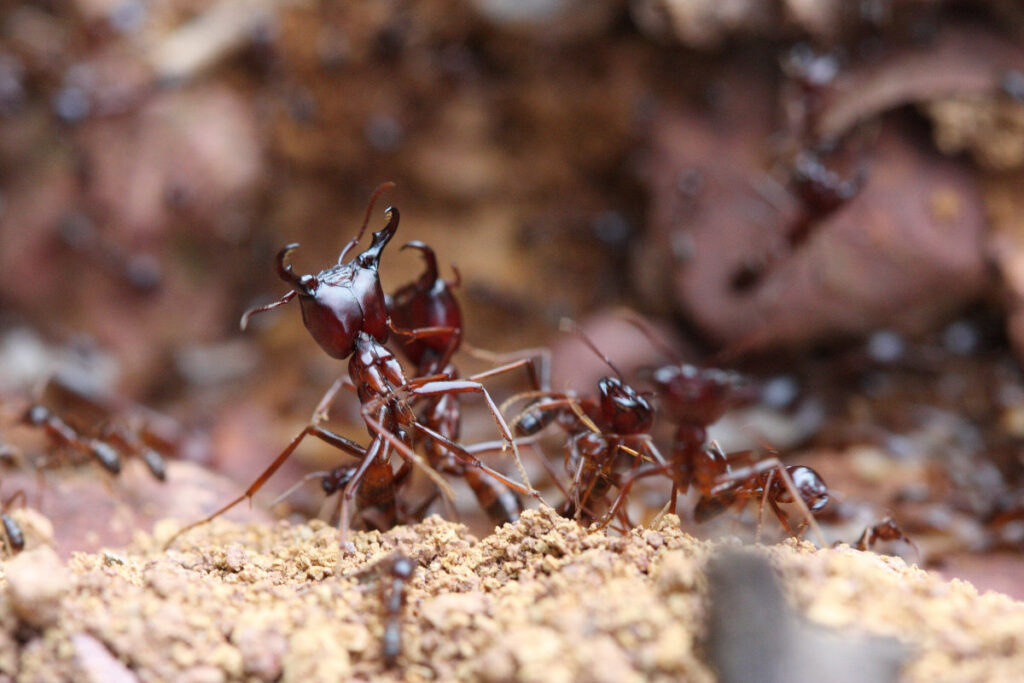[LUM#21] The painstaking task of virus tracking
When we think of the occupants of tropical forests, we think of jaguars, leopards and monkeys of all kinds. Or birds and reptiles such as toucans and chameleons. But there are tiny, tiny inhabitants living there by the millions. These are viruses, a growing source of concern in terms of human health, which virologists Eric Leroy and Philippe Roumagnac are studying closely thanks to ants.

Covid-19, Ebola, HIV. But also hepatitis, measles and mumps. These infectious diseases have one thing in common: they are all of animal origin, as are three-quarters of the epidemics that affect humans. "These are what we call zoonoses. The viruses responsible for these diseases were originally harbored by animals and then passed on to the human species", explains Eric Leroy, virologist at theMivegec laboratory(Maladies infectieuses et vecteurs : écologie, génétique, évolution et contrôle).1.
While these viruses can originate from farmed animals, they most often come from wild animals, mainly living in tropical forests. " On the one hand, because these are the areas richest in biodiversity, and on the other because certain socio-cultural customs increase contact with wild fauna, which favours transmission to humans", explains Eric Leroy.
A public health issue
Scrutinizing these viruses hidden in forests has therefore become a public health issue. " We need to be able to monitor upstream animal reservoirs before viruses reach humans," explains the virologist. But how can we gain a better understanding of the tiny inhabitants of these immense, impenetrable forests?
Eric Leroy, who knows tropical forests well having lived and worked for many years in Gabon and Congo, and his colleague Philippe Roumagnac, virologist at the Montpellier Plant Health Institute(Phim), had an idea. Since it's impossible to capture, sample and analyze all the animals and plants that populate the forests to examine their viruses, why not let others take care of this precious sampling? These others are a whole army of little insects like no others: the legionary ants, or magnan ants.
These carnivores attack everything that falls under their mandibles: from arthropods and other invertebrates to small animals such as birds, reptiles and small mammals. " They are known for the spectacular raids they carry out in columns of millions of individuals stretching over several dozen meters," explains the virologist. Not to be outdone, these nomads also consume the carcasses of large animals when the opportunity arises, hence their nickname of "Africa's dustbins".
"We therefore hypothesized that these magnan ants might be able to absorb and accumulate viruses harbored by the hosts they consume, be they plants, invertebrate animals or vertebrates." By analyzing the genetic material derived from the ants, the researchers hope to identify the viruses with which they have been in contact, and thus gain a better understanding of what they call the tropical forest virosphere.
Pilot study
To test this hypothesis, Eric Leroy and his colleagues carried out a pilot study. They captured 209 ants from around 30 columns in northeast Gabon, and analyzed each of these insects using a viral metagenomics approach. " We recover all the genetic material, DNA and RNA, present within a sample - in this case the ant - to analyze the portion corresponding to the total viral genome, that of the ant but also the genetic material from the animals or plants it has consumed", Eric Leroy explains.
The researchers detected an exceptional number of genomic sequences, 46,000 of which were related to viruses, bacteria, plants, invertebrates and vertebrates. " A veritable Ali Baba's cave", enthuses Eric Leroy. Only half of these sequences corresponded to recognized viral genera, which means that in the forest ecosystems traversed by the ants, there are probably many viruses still unknown".
Sentinel ants
While the researchers will be conducting larger-scale studies, these preliminary results already prove that the idea is a good one. " Not only would this method enable us to gain a better understanding of the virosphere and map the presence of viruses in a given area, but we could also envisage setting up a means of monitoring these zoonotic viruses before they are transmitted to humans", explains the researcher, who envisages, for example, a monthly collection of army ants in defined locations to identify the viruses present there.
"If problematic viruses reach a critical threshold, measures could be put in place," imagines Eric Leroy. These 6-legged sentinels would thus participate in early virus surveillance, making it possible to predict, anticipate and prevent the emergence of diseases and epidemics "which we are still too often merely spectators to, dumbfounded and powerless", concludes the researcher.
UM podcasts are now available on your favorite platforms (Spotify, Deezer, Apple podcasts, Amazon Music...).
- Mivegec (CNRS, UM, IRD)
︎